For image download, domain name resolution and time synchronization, please click Alibaba cloud open source mirror station
Ansible principle
Ansible is an open source automation platform. It is a simple automation language that can perfectly describe the IT application infrastructure in * * Ansible Playbook * *. It is also an automation engine that can run Ansible Playbook.
Ansible can manage powerful automated tasks and adapt to many different workflows and environments. At the same time, ansible new users can use it very quickly to improve work efficiency.
To put it bluntly, other hosts are deployed (controlled) in batches. The controlled host is called the master, and the controlled host is the controlled node
The host of the control node can be Linux or Unix
The host of the controlled node can be Linux, Unix and Windows
Ansible Playbook is like a task book. It adopts YAML text file editing and is easy to read
When you need to use ansible, you only need to download ansible and python on the control node and python on the controlled node (Python version requirements: python27+ / python35 +)
The control node also needs to write * * Ansible list * * and Ansible configuration file. The list groups the controlled nodes. The configuration file specifies the path of the list, the user and connection details of SSH connection, etc
We also need to make some relevant configurations for SSH connection, such as sending public key to facilitate our password free login. For convenience, we configure password free sudo for the users of the controlled node
Build environment
Basic configuration
The basic configuration is mainly some simple configuration. In order to facilitate our experiments, we have also made unified regulations
In order to facilitate our experiment, we choose three different versions of operating systems to do the experiment, which are:
[root@master:~]$ cat /etc/redhat-release Rocky Linux release 8.5 (Green Obsidian) [root@node12:~]$ cat /etc/redhat-release CentOS Linux release 7.8.2003 (Core) [root@node13:~]$ cat /etc/redhat-release CentOS Stream release 8
Of course, it can also be other versions. The official websites to download are: Netease open source mirror station, Tsinghua University open source mirror station and Alibaba open source mirror station
Select the version and name its host name as follows to distinguish the control node from the controlled node:
[root@master:~]$ hostname master [root@node12:~]$ hostname node12 [root@node13:~]$ hostname node13
Configure IP for it. The host bits are 11, 12 and 13 respectively
[root@master:~]$ ip address show ens33
2: ens33: <BROADCAST,MULTICAST,UP,LOWER_UP> mtu 1500 qdisc fq_codel state UP group default qlen 1000
link/ether 00:0c:29:67:de:22 brd ff:ff:ff:ff:ff:ff
inet 192.168.32.11/24 brd 192.168.32.255 scope global noprefixroute ens33
valid_lft forever preferred_lft forever
inet6 fe80::20c:29ff:fe67:de22/64 scope link noprefixroute
valid_lft forever preferred_lft forever
[root@node12:~]$ ip address show ens33
2: ens33: <BROADCAST,MULTICAST,UP,LOWER_UP> mtu 1500 qdisc pfifo_fast state UP group default qlen 1000
link/ether 00:0c:29:b1:4a:7d brd ff:ff:ff:ff:ff:ff
inet 192.168.32.12/24 brd 192.168.32.255 scope global noprefixroute ens33
valid_lft forever preferred_lft forever
inet6 fe80::10eb:4b68:b809:f62f/64 scope link noprefixroute
valid_lft forever preferred_lft forever
[root@node13:~]$ ip address show ens33
2: ens33: <BROADCAST,MULTICAST,UP,LOWER_UP> mtu 1500 qdisc fq_codel state UP group default qlen 1000
link/ether 00:0c:29:b1:6e:60 brd ff:ff:ff:ff:ff:ff
inet 192.168.32.13/24 brd 192.168.32.255 scope global noprefixroute ens33
valid_lft forever preferred_lft forever
inet6 fe80::20c:29ff:feb1:6e60/64 scope link noprefixroute
valid_lft forever preferred_lft forever
Write the DNS resolution to their respective / etc/hosts files (take master as an example here)
[root@master:~]$ cat /etc/hosts 127.0.0.1 localhost localhost.localdomain localhost4 localhost4.localdomain4 ::1 localhost localhost.localdomain localhost6 localhost6.localdomain6 192.168.32.11 master 192.168.32.12 node12 192.168.32.13 node13
ping command test
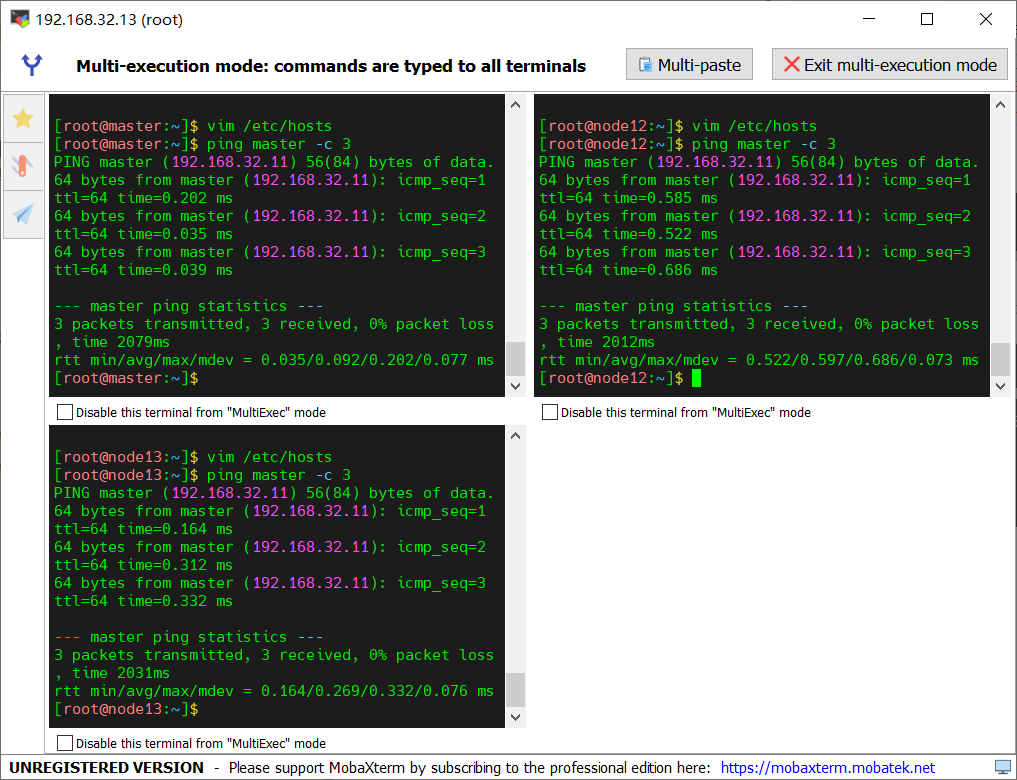
Add users for each host, add student users for each host, and add additional class users for the control node
[root@master:~]$ id student uid=1000(student) gid=1000(student) groups=1000(student) [root@master:~]$ id class uid=1001(class) gid=1001(class) groups=1001(class) [root@node12:~]$ id student uid=1000(student) gid=1000(student) groups=1000(student) [root@node13:~]$ id student uid=1000(student) gid=1000(student) groups=1000(student)
Configure secret free sudo for each student user: vim /etc/sudoers
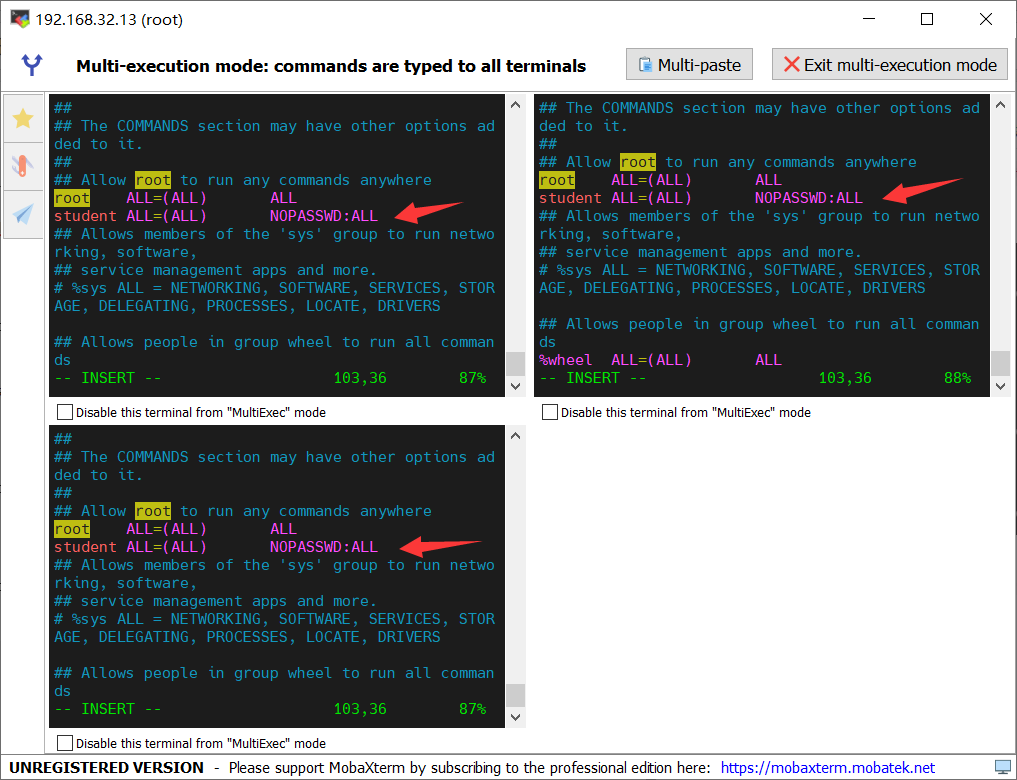
SSH: the control node generates a public-private key and transmits the public key to the student user of the controlled node
##User generated with class # Generate key ssh-keygen # Public key transmission ssh-copy-id student@master ssh-copy-id student@node12 ssh-copy-id student@node13
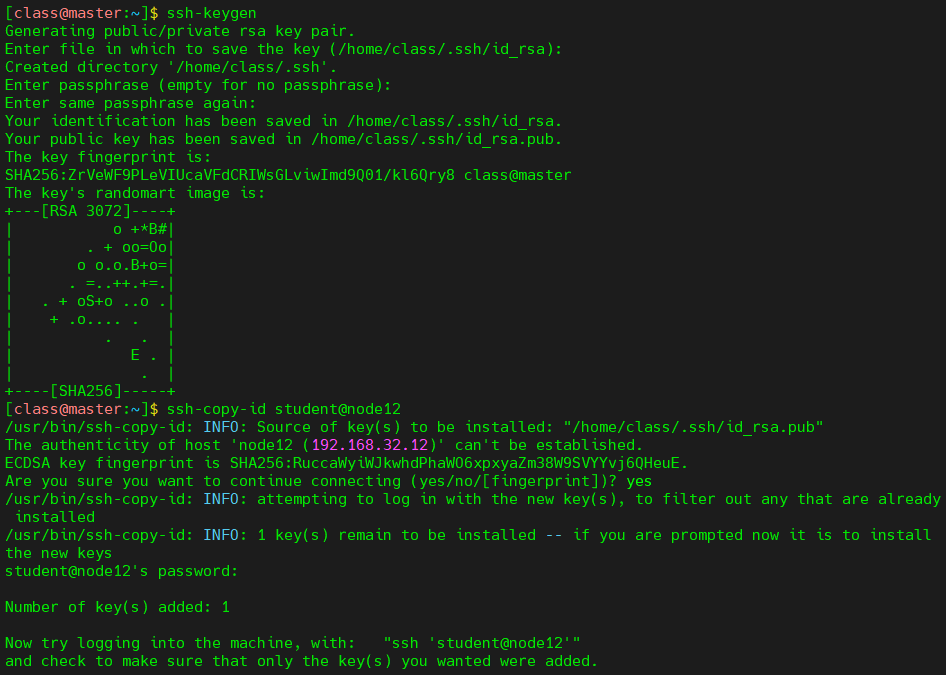
View their home directories
[class@master:~]$ ll /home/class/.ssh/ total 12 -rw------- 1 class class 2602 Feb 19 19:58 id_rsa -rw-r--r-- 1 class class 566 Feb 19 19:58 id_rsa.pub -rw-r--r-- 1 class class 364 Feb 19 19:58 known_hosts [root@master:~]$ ll /home/student/.ssh/ total 4 -rw------- 1 student student 566 Feb 19 19:58 authorized_keys [root@node12:~]$ ll /home/student/.ssh/ total 4 -rw------- 1 student student 566 Feb 19 19:59 authorized_keys [root@node13:~]$ ll /home/student/.ssh/ total 4 -rw------- 1 student student 566 Feb 19 19:59 authorized_keys
Environment configuration
Environment configuration is mainly the downloading of software packages
Let's download python36 for the three hosts: Yum install pyton36 / Yum module install pyton36
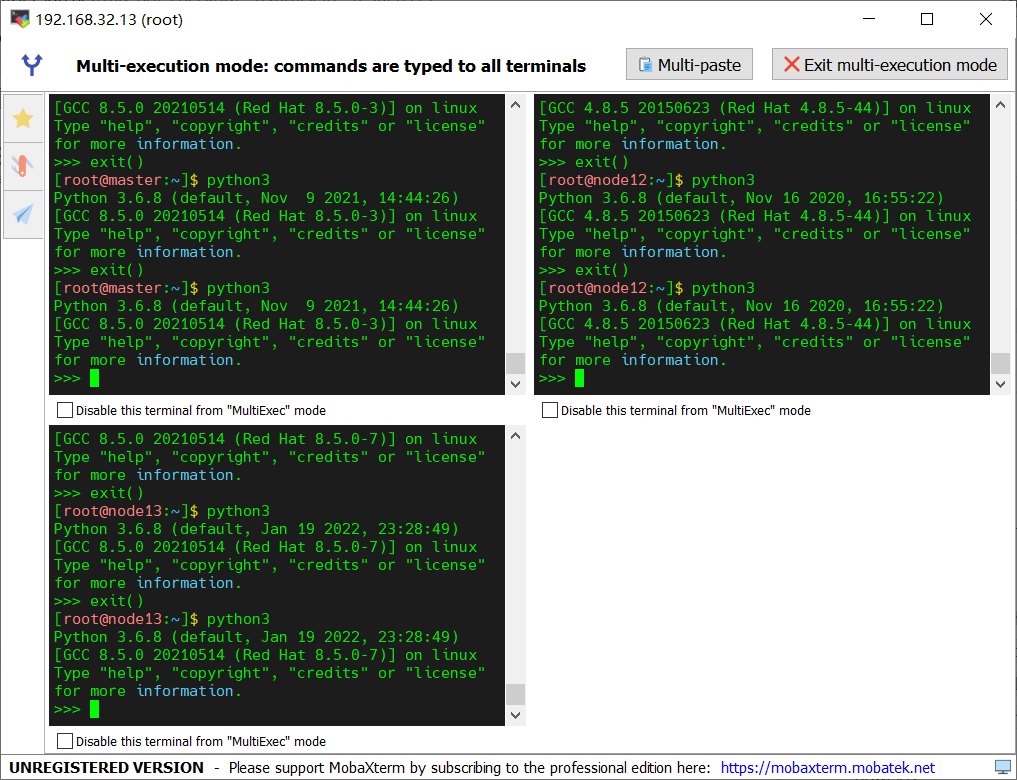
The next step is to install Ansible on the control node. Before installing, we need to write the yum source: VIM / etc / yum repos. d/epel. repo
[epel] name=epel baseurl=https://mirrors.aliyun.com/epel/8/Everything/x86_64/ gpgcheck=0
Next: yum install ansible -y
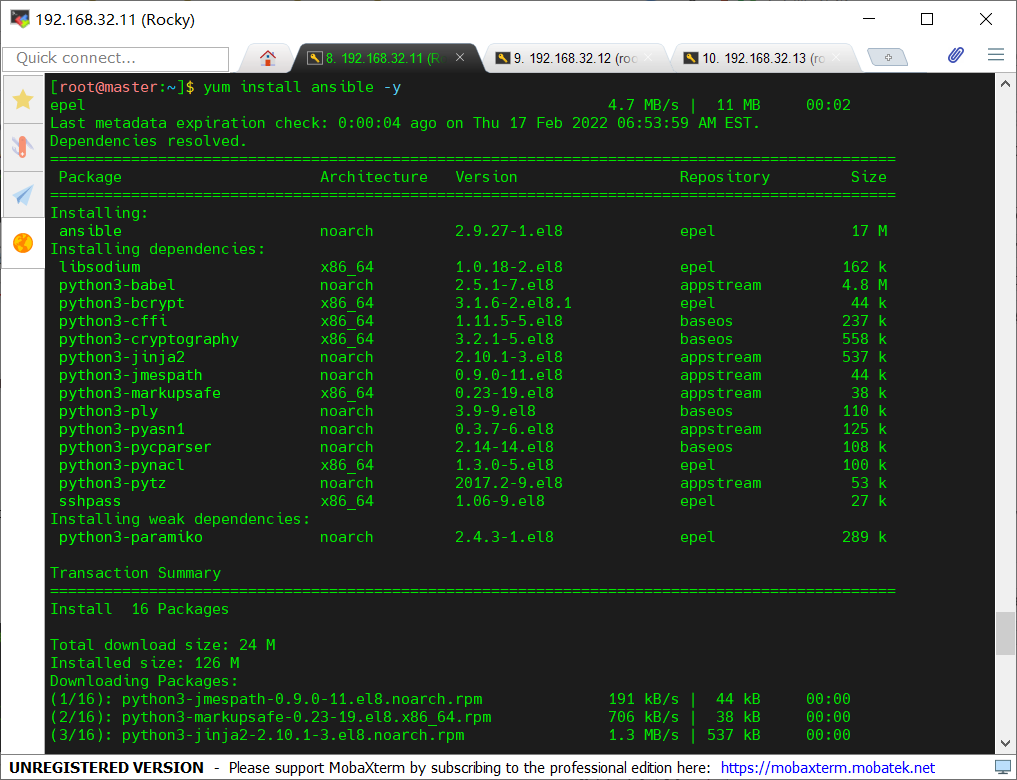
View version: ansible --version
[root@master:~]$ ansible --version ansible 2.9.27 config file = /etc/ansible/ansible.cfg configured module search path = ['/root/.ansible/plugins/modules', '/usr/share/ansible/plugins/modules'] ansible python module location = /usr/lib/python3.6/site-packages/ansible executable location = /usr/bin/ansible python version = 3.6.8 (default, Nov 9 2021, 14:44:26) [GCC 8.5.0 20210514 (Red Hat 8.5.0-3)]
Preparation of documents
We need to write two files (excluding Ansible Playbook): list and configuration file
There are three types of configuration files:
./ansible.cfg # The highest priority is in the working directory ~/.ansible.cfg # Second, in the home directory, it is a hidden file /etc/ansible/ansible.cfg # Lowest priority
Then we will create a new directory as the working directory, write the configuration file under it and execute the Ansible command
Where the ansible command is used, there is the working directory
# The following is the content of the configuration file [defaults] inventory = ./inventory ; Specifies the path to the manifest remote_user = student ; Specify which user to remotely control ask_pass = false ; Set to login without password # There should be spaces on both sides of the equal sign above and a blank line below [privilege_escalation] become=true ; Change to another user after logging in to the controlled host become_method=sudo ; with sudo Change mode to other users( sudo,su) become_user=root ; Become root user become_ask_pass=false ; sudo No password is required
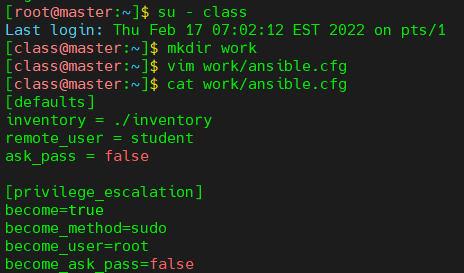
Write a list in the working directory: vim/ The default path of the work / inventory list is / etc/ansible/hosts, but we usually don't use it
node12 node13 # The following are the groups [webservers] master node12 [dbservers] node12 node13 # This is to combine two groups into one group [servers:children] webservers dbservers
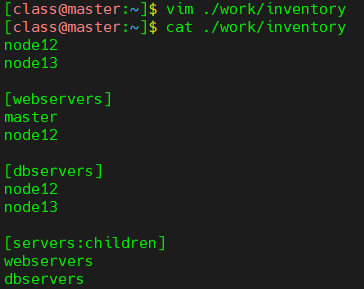
Test: ansible group name or host name -- List hosts [- VVV]
It must be executed in the working directory, otherwise the configuration file will be loaded according to the priority; We can follow the option - v later, which will give a gradually detailed process according to the number of v
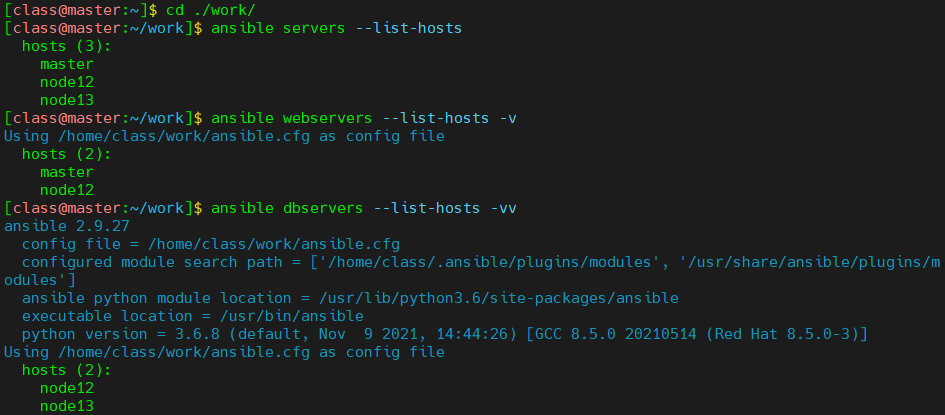
experiment
1. Execute the id command targeting the all host group
2. Use the copy module to modify the / etc/motd file on all hosts. The content is welcome to ansible
3. Use the command module to view the contents of the / etc/motd file
4. Use the user module to create a user xiaoming with a uid of 2000
First create a working directory and edit the list and configuration file under it
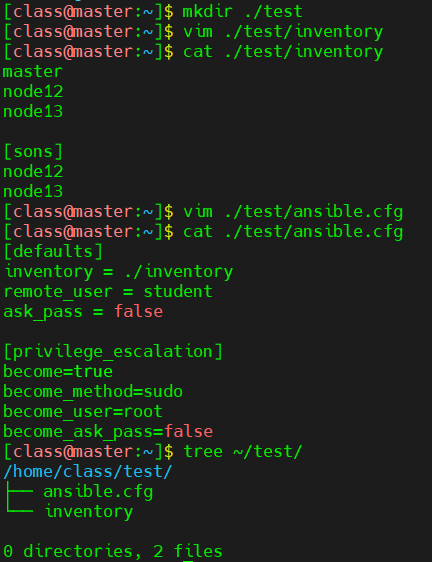
1. Execute the id command targeting the all host group: ansible all -m command -a id

2. Use the copy module to modify the / etc/motd file on all hosts. The content is welcome to ansible: ansible sons -m copy -a 'content="welcome to ansible\n" dest=/etc/motd'
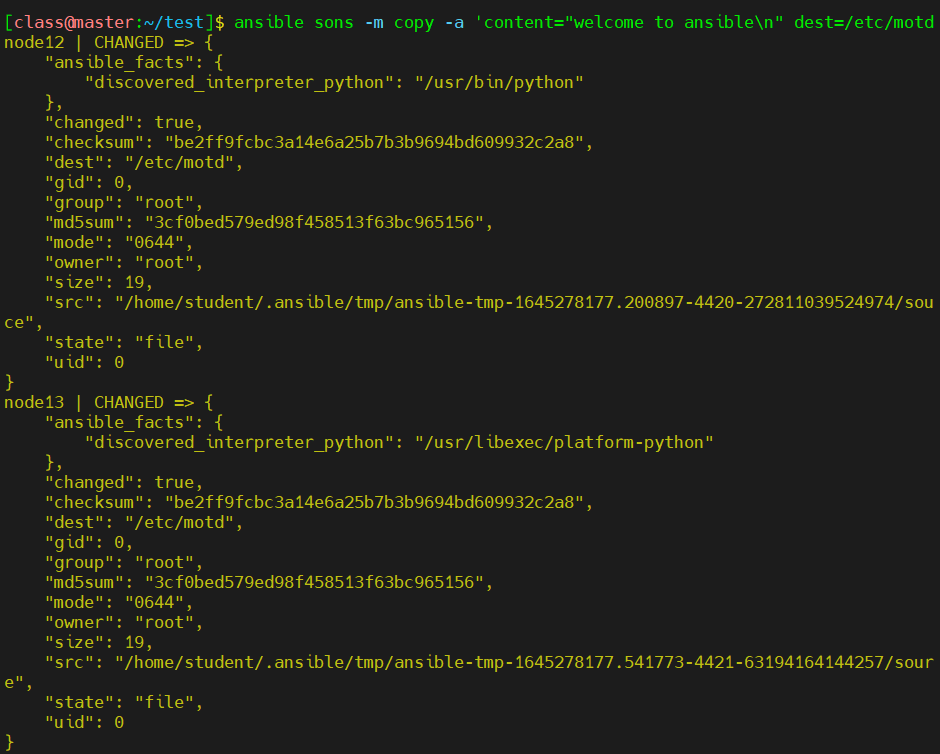
3. Use the · command module to view the contents of the / etc/motd file: ansible sons -m command -a 'cat /etc/motd'

4. Use the user module to create a user xiaoming with uid of 2000: ansible sons -m user -a 'name=xiaoming uid=2000 state=present'
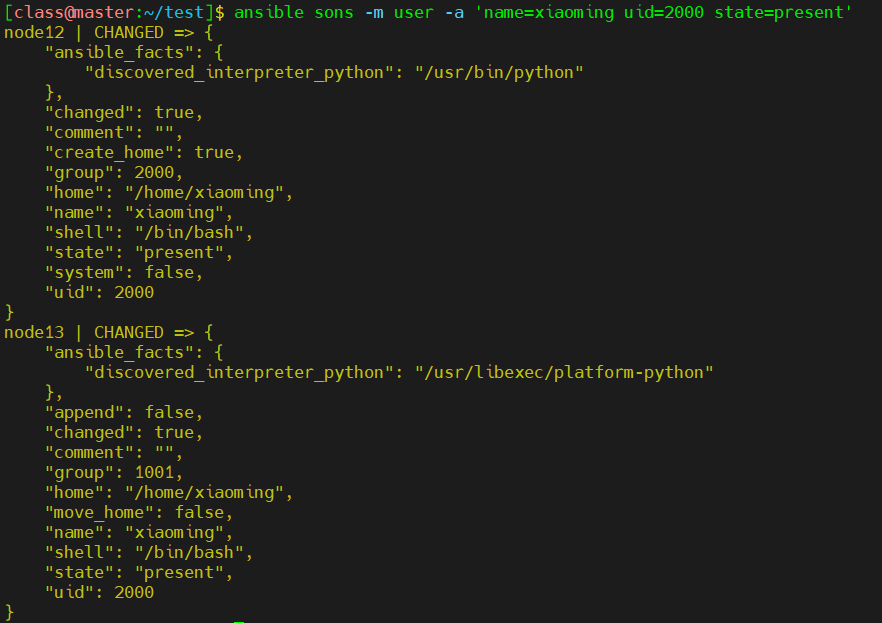
supplement
The usage of Ansible is: Ansible host pattern - M module [- a 'module arguments'] [- I inventory]
These are its temporary commands. Usually, we write these instructions in Ansible Playbook
There are three return values. One is CHANGED, which indicates that the execution is successful and the change has been made; Another is * * SUCCESS * *, which means the execution is successful. It is checked that it is already in this state, so it has not been CHANGED; The last one is FAILED, which is execution error. Accordingly, their colors are also different
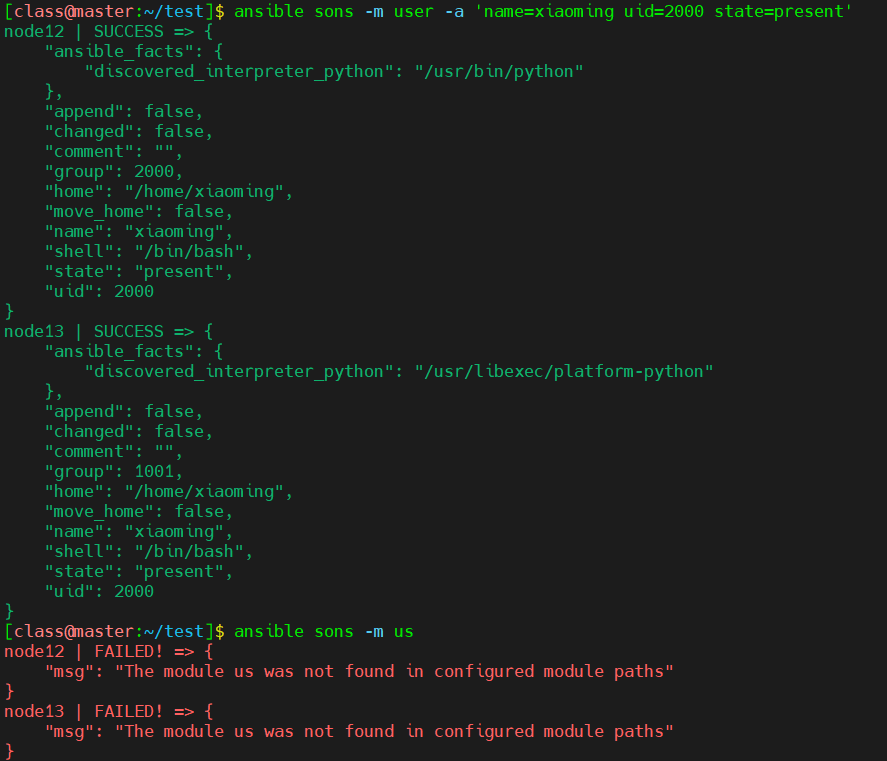
This article is transferred from: https://blog.csdn.net/SuichI314/article/details/123020414